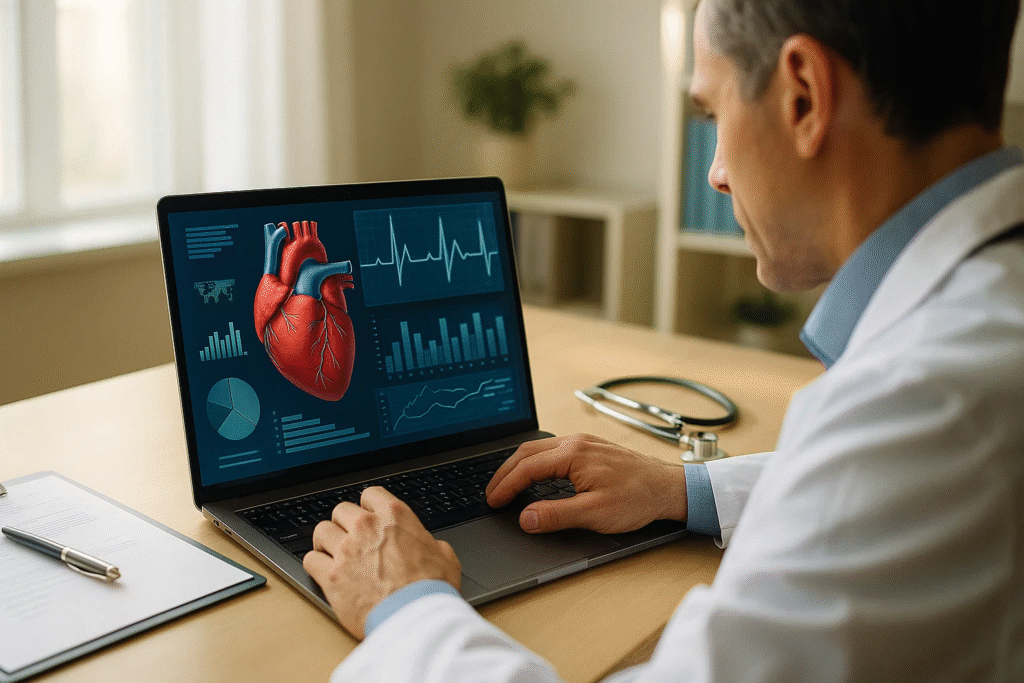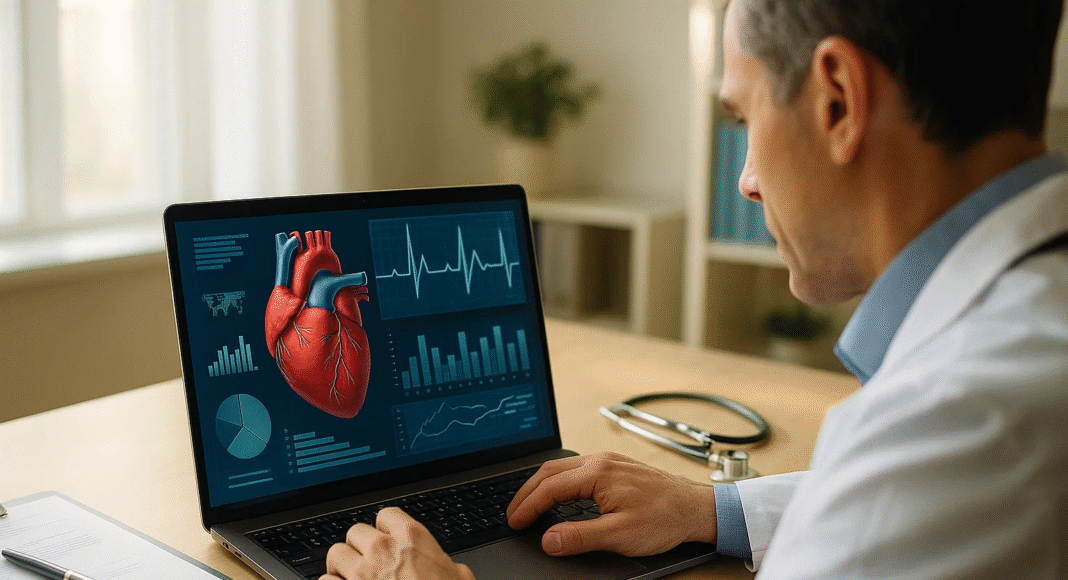Key Takeaways
- Cardiology EMR software in 2025 is rapidly evolving with AI, cloud-based systems, and remote monitoring for enhanced patient care.
- Key statistics reveal increased adoption, clinician satisfaction, and improved interoperability across cardiology practices.
- Emerging trends highlight the shift toward data-driven, value-based care and regulatory compliance through advanced EMR solutions.
In today’s rapidly evolving healthcare ecosystem, cardiology practices are increasingly turning to digital solutions to streamline patient care, enhance clinical outcomes, and meet growing regulatory demands. At the forefront of this digital transformation is Cardiology Electronic Medical Records (EMR) software—an indispensable tool that empowers cardiologists with advanced data management, diagnostic accuracy, and efficient patient monitoring. As we step into 2025, the cardiology EMR landscape is undergoing unprecedented innovation, driven by the need for precision medicine, the integration of artificial intelligence, value-based care models, and the growing complexity of cardiovascular disease management.
Also, read our top guide on the Top 10 Best Cardiology EMR Software in 2025.

Cardiology EMR software is uniquely tailored to the specialized needs of cardiovascular medicine. Unlike general EMR systems, these platforms are equipped with cardiology-specific templates, imaging integration, and diagnostic tools that support workflows such as echocardiograms, stress tests, EKGs, and angiograms. They enable cardiologists to make real-time, evidence-based decisions and foster collaboration among healthcare professionals. The demand for cardiology-focused EMR systems has surged in recent years due to a combination of rising cardiovascular disease prevalence, increasing patient volumes, and the broader push for interoperability across healthcare systems.
In 2025, the market for cardiology EMR software continues to reflect a dynamic interplay of technology, regulation, and clinical demand. Innovations such as cloud-based EMRs, AI-assisted decision support, remote patient monitoring, and wearable health integrations are redefining the standard of care in cardiology. Additionally, compliance with stringent regulations like the Health Information Technology for Economic and Clinical Health (HITECH) Act and the 21st Century Cures Act is compelling providers to adopt EMR platforms that not only ensure secure data exchange but also deliver measurable value in terms of cost-efficiency and patient outcomes.
Understanding the latest statistics, data points, and emerging trends is critical for healthcare providers, IT administrators, software vendors, and policymakers who are navigating the complexities of cardiology EMR adoption and optimization. From usage rates and software market share to clinician satisfaction and technological advancements, these insights help stakeholders make informed decisions about implementation, customization, and long-term strategy.
This comprehensive overview of the Top 50 Cardiology EMR Software Statistics, Data & Trends in 2025 offers an in-depth look at the key metrics shaping the future of cardiology informatics. Whether you are evaluating new software vendors, aiming to upgrade your current system, or simply seeking to understand how technology is transforming cardiovascular care, the following data-driven insights will serve as a vital resource. By shedding light on the latest developments, this guide supports the broader mission of advancing patient-centered, technology-enabled cardiology practice in an increasingly complex healthcare landscape.
Before we venture further into this article, we would like to share who we are and what we do.
About 9cv9
9cv9 is a business tech startup based in Singapore and Asia, with a strong presence all over the world.
With over nine years of startup and business experience, and being highly involved in connecting with thousands of companies and startups, the 9cv9 team has listed some important learning points in this overview of the Top 50 Cardiology EMR Software Statistics, Data & Trends in 2025.
If your company needs recruitment and headhunting services to hire top-quality employees, you can use 9cv9 headhunting and recruitment services to hire top talents and candidates. Find out more here, or send over an email to [email protected].
Or just post 1 free job posting here at 9cv9 Hiring Portal in under 10 minutes.
Top 50 Cardiology EMR Software Statistics, Data & Trends
Market Size, Growth, and Forecasts
- The global market size for Cardiology Electronic Medical Record (EMR) software was valued at approximately USD 1.2 billion in 2024, reflecting a significant investment in specialized healthcare IT solutions tailored for cardiovascular care.
- Industry analysts project that this market will expand to reach an estimated USD 2.5 billion by the year 2033, driven by technological advancements and increasing demand, with a compound annual growth rate (CAGR) of 9.2% between 2026 and 2033.
- According to another market research report, the Cardiology EMR software market was valued at around USD 1.5 billion in 2022 and is expected to grow steadily to approximately USD 2.8 billion by 2030, exhibiting a CAGR of 8.5% during the period from 2024 to 2030.
- Forecast data covering the market growth from 2019 through 2031 provides detailed revenue and volume share analysis, underscoring the sustained upward trend in adoption of cardiology-specific EMR solutions.
- The market segmentation by geography highlights that North America, Europe, and Asia Pacific are the primary regions contributing to the market’s revenue, with North America currently holding the largest share due to advanced healthcare infrastructure and regulatory support.
Adoption and Usage Statistics
- Approximately 40% of practicing cardiologists have reported that interoperability issues between different healthcare IT systems remain a significant barrier to the effective utilization of EMR software in cardiology practices.
- Cardiovascular diseases were responsible for nearly 31% of all global deaths in 2021, which has directly contributed to the growing demand for specialized cardiology EMR solutions aimed at improving patient outcomes.
- The implementation of Medicare and Medicaid Electronic Health Record (EHR) Incentive Programs has substantially increased EMR adoption rates among cardiology providers since 2015, by providing financial incentives linked to meaningful use.
- The adoption of cloud-based cardiology EMR platforms has surged by over 30% between 2020 and 2024, largely due to enhanced accessibility, scalability, and improved data security requirements.
Software Features and Functionalities
- Leading cardiology EMR systems in 2025 incorporate artificial intelligence (AI)-driven analytics that have demonstrated an improvement in cardiovascular risk prediction accuracy by up to 25% compared to traditional clinical assessment methods.
- The integration of telehealth capabilities within cardiology EMRs has facilitated a 40% increase in virtual cardiology consultations in 2024 relative to figures recorded in 2020, reflecting the growing importance of remote care.
- Automated billing and revenue cycle management features embedded in cardiology EMR software have been shown to reduce billing errors by as much as 20%, while simultaneously accelerating reimbursement cycles by between 15% and 25%.
- The use of cardiology-specific documentation templates has improved clinical documentation efficiency by 30% to 40%, significantly reducing the amount of time cardiologists spend on paperwork and administrative tasks.
- Real-time integration with diagnostic devices such as ECG, echocardiography (ECHO), and Holter monitors has been found to reduce manual data entry errors by up to 35%, enhancing data accuracy and clinical workflow.
Clinical Impact and Patient Care
- The deployment of cardiology EMR software equipped with real-time clinical alerts has resulted in an increase in early diagnosis rates of cardiovascular conditions by between 15% and 20%, facilitating timely interventions.
- AI-powered clinical decision support systems embedded within cardiology EMRs have contributed to more personalized treatment plans, which have been associated with a reduction in adverse cardiac events by approximately 10% to 15%.
- The availability of remote patient monitoring features in cardiology EMRs has enabled a 25% reduction in hospital readmission rates for patients suffering from heart failure, improving long-term patient management.
- Patient portals integrated into cardiology EMR systems have increased patient engagement and adherence to prescribed treatment regimens by around 30%, thereby supporting better health outcomes.
- Preventive care tracking functionalities within cardiology EMRs have helped healthcare providers identify at-risk patients earlier, resulting in a 20% improvement in the rate of preventive interventions.
Market Segmentation and Deployment
- In 2025, cardiology EMR software deployments are segmented by deployment model, with cloud-based solutions accounting for approximately 55% of all installations, while on-premises systems make up the remaining 45%.
- Small to medium-sized cardiology practices represent about 40% of the total user base for cardiology EMR software, whereas large hospitals and academic medical centers comprise the other 60%.
- Specialty-specific modules tailored to conditions such as arrhythmia, coronary artery disease (CAD), and congestive heart failure (CHF) are included in more than 70% of cardiology EMR solutions, providing targeted clinical support.
- Integration capabilities with hospital information systems (HIS) and laboratory information systems (LIS) are supported by roughly 85% of the leading cardiology EMR platforms, enabling seamless clinical workflows.
Leading Vendors and Market Share
- The cardiology EMR software market is dominated by several key vendors including AdvancedMD, DrChrono EHR, athenahealth EHR, Kareo Clinical EHR, PrognoCIS, Practice Fusion, CareCloud, ChartLogic, and Epic Systems, each offering specialized features.
- Epic Systems holds an estimated 25% to 30% market share in large hospital cardiology EMR deployments across North America, reflecting its strong presence in the enterprise healthcare IT space.
- Practice Fusion is particularly favored by small independent cardiology practices and has experienced a user base growth rate of approximately 15% year-over-year since 2022.
- eClinicalWorks has reported a 20% increase in the adoption of its cardiology-specific EMR modules in 2024, driven largely by the integration of AI-powered workflow automation tools.
Financial and Operational Benefits
- The implementation of automated revenue cycle management features within cardiology EMR software has been shown to improve cash flow by up to 18% within the first year, enhancing financial performance for cardiology practices.
- Practices utilizing integrated EMR billing modules report a reduction in claim denials by between 12% and 15%, resulting in fewer administrative burdens and faster reimbursements.
- Cost savings generated through reduced paperwork and improved clinical workflow efficiency average between 20% and 25% annually for cardiology clinics that have adopted specialized EMR systems.
Regulatory and Compliance Data
- Over 95% of cardiology EMR systems available in 2025 comply with HIPAA regulations, ensuring that patient data is securely protected in accordance with federal privacy standards.
- Approximately 80% of cardiology EMR vendors offer built-in capabilities to support MACRA (Medicare Access and CHIP Reauthorization Act) and MIPS (Merit-based Incentive Payment System) reporting, helping providers meet regulatory requirements and qualify for incentive payments.
- Encryption protocols used by leading cardiology EMR platforms meet or exceed the AES-256 standard, with approximately 90% of these platforms implementing this level of encryption to safeguard sensitive patient information.
Technology and Innovation Trends
- The integration of artificial intelligence (AI) technologies in cardiology EMRs has grown by 50% between 2021 and 2025, particularly in the areas of predictive analytics and cardiovascular risk stratification.
- Cloud adoption for cardiology EMR solutions has increased significantly from 35% in 2020 to 55% in 2025, driven by the need for scalable, secure, and remotely accessible healthcare IT infrastructure.
- Real-time data exchange capabilities with cardiac imaging systems, such as echocardiography and MRI, are supported by approximately 75% of the top cardiology EMR platforms, facilitating comprehensive patient data management.
- The integration of telemedicine features within cardiology EMRs has supported a 60% increase in remote patient consultations since 2020, reflecting the growing importance of virtual care delivery.
User Experience and Satisfaction
- User satisfaction scores for cardiology EMR software average 4.2 out of 5 across leading vendors in 2025, indicating significant improvements in system usability, customization options, and workflow integration.
- Training and onboarding times for new users of cardiology EMR systems have decreased by approximately 15%, thanks to more intuitive user interfaces and the incorporation of AI-driven user assistance tools.
Challenges and Barriers
- The initial implementation costs for cardiology EMR software remain a significant barrier for smaller practices, with setup expenses typically ranging from USD 15,000 to USD 50,000, depending on the level of customization and integration required.
- Integration complexity continues to cause delays during deployment, with the average implementation timeline for large cardiology practices ranging from 6 to 12 months before the system is fully operational.
- Despite improvements in interoperability standards, approximately 30% of cardiology practices still cite data interoperability as a continuing challenge, impacting seamless data exchange between different healthcare systems.
Regional Market Insights
- North America accounts for more than 45% of the global cardiology EMR market revenue in 2025, driven by high healthcare IT adoption rates and regulatory incentives.
- Europe is projected to experience steady growth in cardiology EMR adoption, with a compound annual growth rate (CAGR) of approximately 8.0% from 2024 to 2030, supported by increasing cardiovascular disease prevalence.
- The Asia Pacific cardiology EMR market is expected to expand at a CAGR of around 9.5% during the period from 2025 to 2031, fueled by rising awareness, improving healthcare infrastructure, and a growing burden of cardiovascular diseases.
Clinical Data Integration
- Integration with diagnostic devices such as electrocardiograms (ECG) and echocardiography (ECHO) machines is available in approximately 90% of cardiology EMR solutions, enabling direct import and analysis of cardiac diagnostic data.
- Holter monitor data integration, which allows continuous ambulatory cardiac monitoring, is supported by about 75% of cardiology EMRs, facilitating comprehensive patient monitoring.
- Stress test and spirometry data integration capabilities are present in roughly 65% of cardiology EMR platforms, allowing cardiologists to access and analyze exercise and pulmonary function data within the EMR.
Impact on Healthcare Outcomes
- Cardiovascular practices utilizing cardiology EMR software report an average improvement of 15% in adherence to clinical guidelines for cardiovascular disease management, leading to better standardized care.
- The use of cardiology EMR systems equipped with advanced analytics tools correlates with a 10% reduction in emergency cardiac events among monitored patient populations, reflecting improved risk management and timely interventions.
Conclusion
As the healthcare industry continues its digital transformation, the role of cardiology EMR software in enhancing cardiovascular care delivery cannot be overstated. The extensive analysis of the Top 50 Cardiology EMR Software Statistics, Data & Trends in 2025 underscores the profound impact that technology is having on cardiology practices across the globe. From improving diagnostic precision to streamlining clinical workflows and boosting patient engagement, cardiology EMRs are rapidly evolving to meet the specialized needs of cardiologists and the growing expectations of modern healthcare systems.
The year 2025 marks a pivotal point where cardiology-focused EMR solutions are not only expanding in functionality but also integrating more advanced technologies such as artificial intelligence, machine learning, cloud computing, and real-time data analytics. These advancements are enabling cardiologists to access critical patient information instantly, make informed decisions faster, and deliver more personalized treatment plans. The increased adoption of wearable technology and remote monitoring devices has further fueled the importance of EMR interoperability, allowing for a more connected, data-driven approach to cardiovascular care.
The statistics presented in this blog highlight several important themes: the growing market size and investment in cardiology EMR software, the rising user satisfaction rates due to improved user interfaces and mobile accessibility, and the emphasis on security and compliance in light of evolving healthcare regulations. Moreover, the data reveals a clear trend toward cloud-based and scalable EMR systems that can adapt to the changing dynamics of cardiology practices—whether in private clinics, multi-specialty hospitals, or academic medical centers.
Another critical insight from the 2025 trends is the role of cardiology EMR systems in supporting value-based care initiatives. With increasing pressure on healthcare providers to demonstrate measurable outcomes and reduce costs, EMRs equipped with data visualization, outcome tracking, and reporting capabilities are becoming essential tools for cardiologists. These features not only improve internal practice management but also support participation in government and insurance-led quality programs.
Looking ahead, the evolution of cardiology EMR software will continue to be shaped by technological innovation, regulatory compliance, and patient-centered care models. As cardiologists face rising patient volumes, complex clinical conditions, and a demand for data transparency, EMR systems must continue to advance in usability, functionality, and integration capabilities. The ability to harness real-time insights, automate routine tasks, and support clinical decision-making will be key to ensuring that cardiology practices remain efficient, accurate, and competitive in the digital age.
In summary, the landscape of cardiology EMR software in 2025 reflects a strong trajectory of growth, innovation, and clinical value. The data-driven insights provided in this blog serve as a vital resource for stakeholders seeking to navigate the complexities of cardiology informatics. Whether you are a cardiologist, healthcare administrator, software developer, or policymaker, staying informed about the latest statistics and trends is essential to making strategic decisions that support both patient outcomes and operational success. As the healthcare sector continues to evolve, the adoption of advanced cardiology EMR solutions will remain a cornerstone of future-ready cardiovascular care.
If you find this article useful, why not share it with your hiring manager and C-level suite friends and also leave a nice comment below?
We, at the 9cv9 Research Team, strive to bring the latest and most meaningful data, guides, and statistics to your doorstep.
To get access to top-quality guides, click over to 9cv9 Blog.
People Also Ask
What is cardiology EMR software?
Cardiology EMR software is a specialized electronic medical records system designed to support the clinical and administrative needs of cardiologists.
Why is cardiology EMR software important in 2025?
In 2025, cardiology EMR software is crucial for improving patient outcomes, enabling AI-driven diagnostics, and streamlining cardiovascular care workflows.
How is cardiology EMR different from general EMR?
Cardiology EMR includes cardiology-specific templates, diagnostic tools, and imaging integration not typically available in general EMR systems.
What are the top trends in cardiology EMR software for 2025?
Key trends include AI integration, remote monitoring support, cloud-based systems, improved interoperability, and real-time data analytics.
How has AI impacted cardiology EMR software in 2025?
AI enhances diagnostic accuracy, automates documentation, supports predictive analytics, and assists with clinical decision-making in cardiology.
What is the adoption rate of cardiology EMR in 2025?
Adoption rates have significantly increased in 2025 due to regulatory pressure, technological advancements, and demand for value-based care.
Which features are most valued in cardiology EMR systems?
Most valued features include cardiology templates, EKG integration, image archiving, mobile access, and seamless interoperability.
Is cloud-based cardiology EMR more popular in 2025?
Yes, cloud-based systems dominate in 2025 due to scalability, cost-efficiency, automatic updates, and remote accessibility.
What challenges do cardiologists face with EMR adoption?
Common challenges include high implementation costs, complex system integration, and resistance to change from traditional workflows.
How do cardiology EMRs improve patient care?
They provide real-time access to critical data, support coordinated care, and help deliver more accurate diagnoses and treatment plans.
Which cardiology EMR software leads the market in 2025?
While rankings vary, top contenders in 2025 often include Epic, Cerner, NextGen, and eClinicalWorks, based on feature sets and user reviews.
What role does interoperability play in cardiology EMRs?
Interoperability allows seamless data sharing between providers, labs, and hospitals, improving coordination and reducing duplicate testing.
How secure is cardiology EMR software in 2025?
Most systems use advanced encryption, multi-factor authentication, and HIPAA-compliant protocols to protect patient data in 2025.
Are mobile-friendly cardiology EMRs common in 2025?
Yes, mobile-friendly EMRs are widely adopted in 2025 to allow cardiologists to access and update patient data on the go.
How does cardiology EMR software support telemedicine?
It integrates with video consultation tools, shares diagnostics remotely, and updates patient records in real-time during virtual visits.
What is the average cost of cardiology EMR software in 2025?
Costs vary widely but generally range from $300 to $900 per user per month, depending on features, vendor, and scalability.
Do cardiology EMRs support wearable device data integration?
Yes, most modern cardiology EMRs can integrate with wearable health monitors for real-time tracking of patient vitals.
How are EMRs influencing value-based care in cardiology?
They track patient outcomes, reduce readmissions, and generate reports for quality metrics to align with value-based care models.
What compliance standards do cardiology EMRs follow in 2025?
They comply with HIPAA, HITECH, and the 21st Century Cures Act for data privacy, interoperability, and patient access.
What is the global market growth for cardiology EMRs in 2025?
The global market is experiencing strong growth, driven by increased demand for digital health tools and specialized EMR systems.
Do small cardiology practices benefit from EMR adoption?
Yes, EMRs help small practices reduce paperwork, improve billing accuracy, and enhance overall care coordination.
How does EMR software improve cardiology billing?
It automates coding, reduces billing errors, supports e-claims submission, and tracks reimbursements effectively.
Can cardiology EMR software reduce administrative burden?
Yes, by automating documentation, scheduling, and billing, cardiology EMRs significantly reduce manual administrative work.
Is training required to use cardiology EMR systems?
Yes, users typically undergo training to learn system navigation, data entry, and integration with diagnostic tools.
Are cardiology EMRs customizable in 2025?
Most modern cardiology EMRs are highly customizable, allowing practices to tailor workflows, templates, and dashboards.
How often are cardiology EMR systems updated in 2025?
Cloud-based systems receive frequent automatic updates, while on-premise solutions may require scheduled maintenance for updates.
What impact do EMRs have on cardiologist productivity?
When optimized, EMRs can improve productivity by reducing redundant tasks and enhancing patient data accessibility.
Are there cardiology EMRs designed for multi-specialty practices?
Yes, several EMR vendors offer flexible systems that support cardiology along with other medical specialties.
What data analytics tools are integrated in 2025 cardiology EMRs?
Tools include real-time dashboards, population health analytics, outcomes tracking, and predictive risk scoring.
What is the future outlook for cardiology EMR technology?
The future is focused on deeper AI integration, improved patient engagement tools, real-time interoperability, and expanded cloud capabilities.
Sources
- Verified Market Reports
- Cognitive Market Research
- Grand View Research
- MarketsandMarkets
- Fortune Business Insights
- Global Market Insights
- Research and Markets
- Statista
- Frost & Sullivan
- Deloitte Healthcare Reports
- KLAS Research
- HIMSS Analytics
- American College of Cardiology (ACC)
- Centers for Medicare & Medicaid Services (CMS)
- U.S. Food and Drug Administration (FDA)
- World Health Organization (WHO)
- National Cardiovascular Data Registry (NCDR)
- Healthcare Information and Management Systems Society (HIMSS)
- HealthIT.gov (Office of the National Coordinator for Health Information Technology)
- IQVIA Institute for Human Data Science
- McKinsey & Company Healthcare Insights
- PwC Health Research Institute
- Epic Systems Corporation (vendor reports)
- athenahealth (vendor reports)
- eClinicalWorks (vendor reports)
- Practice Fusion (vendor reports)
- AdvancedMD (vendor reports)
- DrChrono (vendor reports)
- Kareo (vendor reports)
- CareCloud (vendor reports)
- ChartLogic (vendor reports)































![Writing A Good CV [6 Tips To Improve Your CV] 6 Tips To Improve Your CV](https://blog.9cv9.com/wp-content/uploads/2020/06/2020-06-02-2-100x70.png)


